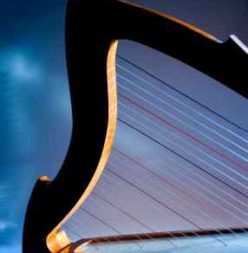Healing Music for Healthcare Patients,
Family and Staff
 Upon hearing the Celtic harp, most people readily understand how the enchanting sounds of the instrument are relaxing to people in stressful healthcare situations. Of course, people everywhere are fascinated by the music and by the harp itself, and happy to recieve the gift of such beautiful sounds. But the effects of therapeutic harp music go far beyond the simple pleasures of “pretty music.”
Upon hearing the Celtic harp, most people readily understand how the enchanting sounds of the instrument are relaxing to people in stressful healthcare situations. Of course, people everywhere are fascinated by the music and by the harp itself, and happy to recieve the gift of such beautiful sounds. But the effects of therapeutic harp music go far beyond the simple pleasures of “pretty music.”
~ Albert Schweitzer
The Benefits of Live Therapeutic Harp Music
According to current research, live therapeutic music can:
• Facilitate the transition process of the dying
• Augment pain management of the terminally ill
• Relieve anxiety of the critically ill
• Accelerate physical healing of post-surgery & injured clients
• Ease the delivery process of the birthing mother
• Reduce stress & blood pressure of the chronically ill
• Relieve body & mental tension of the pre-surgery client
• Aid mental focus
• Lift and clear the consciousness
Documented physical benefits from listening to therapeutic harp music include lowered blood pressure, decrease in heart rate, and an increase in oxygenation levels. In addition, studies show that patients often require lower amounts of painkillers and experience reduced anxiety and improved mood while under the influence of therapeutic harp music.
The live experience of healing music creates a much greater benefit to patients than recorded music, not least because of the full spectrum of acoustic sound vibrations provided.
~ Mitchell Gaynor, Sounds of Healing
What is a Certified Therapeutic Harp Practitioner?
Certified Therapeutic Harp Practitioners are trained in inclusive attention, resonant tone, the application of musical modes, and empathetic communication techniques. They use this training, as well as ongoing monitoring of the recipient’s physical and verbal responses, to guide them in the selection of healing harp music that not only pleases the recipient but is the most appropriate for his or her needs in any given moment. Therapeutic harp music supports the individual with a cradle of sound, so maximum healing may unfold. The music usually supports not only the patient, but the family members and professionals involved in his or her care.
According to Christina Tourin, Founder and Director of The International Harp Therapy Program, “Practitioner graduates of the International Harp Therapy Program use the small harp as a bedside instrument with the intention of supporting the goal of healing. This goal may be emotional, physical, mental or spiritual in nature.
Music played on the harp has several unique healing properties. The resonance from the strings, including the range of pitch and tonal color, sets up an important relationship between the sound and the listener. Historically, the harp has been a symbol of relief and comfort. It is one of the most characteristic instruments of a timeless healing tradition.”
Susan Zevenbergen is a Certified Therapeutic Harp Practitioner, a 2006 graduate of the International Harp Therapy Program. She also holds a Certificate from San Diego Hospice and Palliative Care, where she completed an internship. Prior to that she interned at North Colorado Medical Center, where she provided bedside harp music to patients in the Center for Acute Intensive Rehabilitation, the Transitional Care unit, and the Ortho-Neurological unit.
For more information about Ask a question about therapeutic harp and healing music services.

